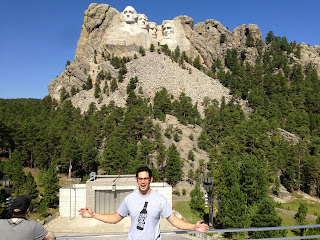Seeing Mount Rushmore
And Mount Rushmore.
It’s difficult to say exactly why I was so adamant about seeing Mount Rushmore. I’ve never felt an inordinate patriotic fervor, nor considered myself a history buff. And yet something about seeing those four dead presidents’ faces carved into the side of a mountain captured my imagination, and felt like essential part of the cross-country trek.
All that, and I struggled to imagine why else I’d find myself in or around South Dakota, and with little desire to do more than see the memorial, it hardly seemed justify a trip of its own.
Heather and I pulled into Keystone at around ten o’clock at night. I’d reserved a room at the Presidents View Resort, an $80 a night lodging that touted its view of the presidents’ faces from the foot of the mountain. I had hoped I that I might be able to see everything I was interested in right there from the hotel parking lot and be on my way.
We arrived late enough that we wouldn’t catch sight of the mountain by daylight, but I imagined it might be lit up and we’d have the benefit of seeing it in spotlights upon our arrival, a different view by daylight, and then we’d be on our way.
I was partially correct. The monument was lit and we could see it from the hotel, but it turned out the best view we had was from the parking lot and the best the angle had to offer was a profile view of George Washington—and he looked awfully small from there, too.
I had spent ten hours behind the wheel, the final two of them clutching the Budget moving truck’s steering wheel with white knuckles against the winding road and complete lack of streetlights or businesses. I told Heather she didn’t have to come with me, but that I wanted to see Mount Rushmore head on that night.
We set off together, not in the truck, but on foot, downhill and down the road into a strip of village a little shy of a quarter mile from the hotel. I felt convinced we’d be able to see the faces of all four presidents head on from the vantage point of that village but as we made our descent, the mountain and the glow of light became less visible and despite my insistence to the contrary, did not come into clearer view when we reached the small strip of businesses (or, ten minutes later, when we had reached the opposite end of it).
So I resigned myself to the idea that we wouldn’t see Mount Rushmore in all its glory that night. We wandered past businesses, taking pictures with a ceramic mule and not entirely racially sensitive portrayals of Native Americans outside old west style saloons, convenience stores done up to approximate old apothecaries, and a slew of smaller outfits peddling t-shirts and snowglobes to commemorate the location.
On my phone, I had programmed a different song to play to wake us each morning of our trip--Counting Crows’ “Omaha” in the eponymous city, Eddie Money’s “Take Me Home Tonight” to close the final sleep of our journey. In Keystone, South Dakota, we woke to P!nk’s “Dear Mr. President.” After a breakfast buffet and showers, we reloaded our suitcases into the back of the moving truck and allowed our smart phones to navigate the way toward the mountain.
Not unlike the little village we had stayed adjacent to, everything about Mount Rushmore itself was artificial and conceived for the benefit of tourists. After we had parked the truck amidst a mismatch of RVs and moving trucks even larger than my own, we zigzagged on foot through a maze of people shooting family portraits or selfies with the presidents in the background--a set of obstacles that we, admittedly, contributed to, as we took our own pictures. At a dull moment, I read about the history of the place on my phone. That Native Americans had called the mountain Six Grandfathers, and it had been renamed when New York lawyer Charles Rushmore traveled through the area and appropriated it for himself.
We ventured closer and closer the mountain as the presidents’ faces grew clearer and larger--far closer to what I had imagined of the monument than the miniature version that appeared from outside the hotel. We settled at the edge of an amphitheater where we had a clear shot of the mountain and could see the edges of trails that would lead us closer and closer. We took more photos there and took turns holding up pennies next to Lincoln, quarters next to Washington, posing with index fingers in the air as though we picked the presidents’ noses.
And we were on our way.
I don’t regret my visit to Mount Rushmore. The experience was not revelatory, as I’d hoped it might have been for my inordinate excitement to see the space. But I’d also had enough experiences to know that so few measure up to our wildest dreams or ill-defined intentions. I think I would have regretted not seeing it, and thus the stop was worthwhile if for no other purpose than that.
So, as we rolled on toward our next stop in Wyoming, I left Mount Rushmore not unlike I had left behind Baltimore and the life I’d lived there, a shave disillusioned, but more thankful the experience. More important than any of that, ready for the next destination.


Comments
Post a Comment